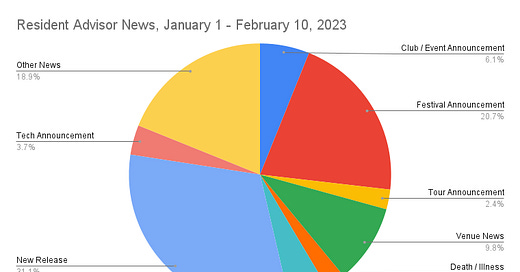Dissecting Electronic Music News
a.k.a. A detailed breakdown of recent news offerings from the genre's leading publications.
One of the strangest things about music journalism—and frankly, pretty much all cultural journalism—is how much conjecture is involved. While it’s thankfully not a completely fact-free zone, music writing does tend to be a highly subjective craft, and most of those taking part don’t approach their work with anything approaching a scientific, data-driven methodology. In many cases, there isn’t even all that much relevant data available, and though good journalists will bolster their work with links, quotes, and historical examples, it’s often the writer’s own opinion—or “take,” to use a less complimentary term— that provides an article with its narrative thrust.
That’s certainly the case with First Floor, as my long-form pieces here in the newsletter frequently hew closer to opinion columns than investigative reporting. Certain things simply can’t be proved, and when it comes to topics like intergenerational tensions in dance music or whether the genre should be treated as a kind of folk art, the best I can do is try to construct a compelling argument.
Two weeks ago, I attempted to do just that when I put together a (not terribly positive) look at the current state of the electronic music press, and questioned why the wider industry continues to bolster media outlets that are so clearly falling short of their stated goals. The essay wasn’t something I just pulled out of thin air—having worked in music for more than two decades, I’d like to think I bring at least some level of insight to the table—but during the time since it was published, I’ve found myself wondering if my observations and critiques could be quantified in some way. Convincing publications to grant me a look at their accounting ledgers is likely out of the question, but I realized that there is some readily available evidence that literally anyone can examine more closely: the content that these outlets publish almost every single day.
When talking about the electronic music press, it’s easy to make generalizations and say things like, “All these sites publish anymore is festival news.” But is that true? It may feel true, but the only way to find out for sure is to dive into their archives and start making notes of what’s been published. So that’s what I did. Maybe I was just excited after last week’s First Floor article about shrinking track times—the piece involved a fair amount of data collection and even included a chart—but over the past few days, I spent hours combing through the news sections of electronic music’s three most prominent publications: Resident Advisor, DJ Mag and Mixmag.
Why the news sections? Because news—which these outlets publish more of than any other content type—provides a clear window into what publications are doing on a day-to-day basis. News may not be as painstakingly curated as things like reviews and features—the latter in particular are often used by editors to overtly signal how they want their publications to be perceived by the public and wider music industry—but there is a curatorial aspect to its creation. Journalists are flooded with press releases and PR pitches every day, and also come across all sorts of interesting things on their own. They can’t write a news story about everything, so they have to choose what items are “worthy” of a piece on their site.
At its core, the decision to publish a news story is rooted in the idea that “this information is important / interesting enough that it ought to be shared with our audience.” As innocent as that may sound, making that determination requires numerous value judgements, namely about who and what matters. Moreover, the fact that decisions about which stories to publish have to be made quickly—digital media incentivizes both speed and volume when it comes to content creation—perhaps makes them even more illuminating, particularly when they’re examined in bulk.
In recent years, Resident Advisor, DJ Mag and Mixmag have all made loud proclamations about their renewed commitments to diversity and community, pledging to not only highlight a wider variety of artists, but to tell a wider range of stories. Attempts to follow through on those pledges have taken place most visibly via features, cover stories (both print and digital) and of course social media, but has the effort trickled down to their news coverage as well? I was determined to find out, and considering that news stories offer a more unfiltered look at publications’ biases (i.e. what their priorities are and what they actually think is important), I also figured that taking a detailed look would shed some light on how closely their editorial rhetoric lines up with the work that’s actually being done.
It also afforded me the chance to make a bunch of new charts and graphs, which I’m sure at least a few data geeks will appreciate.



